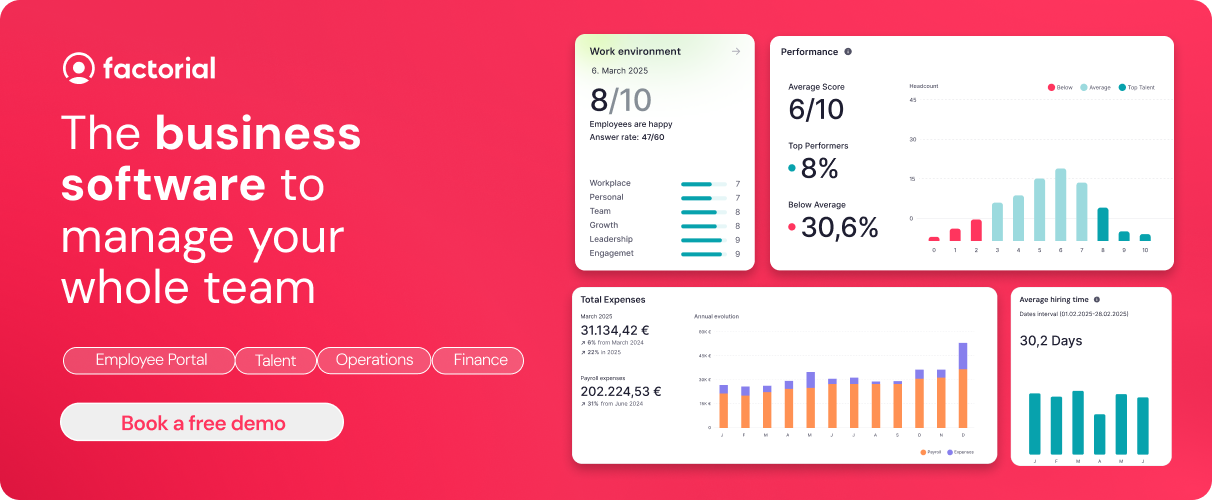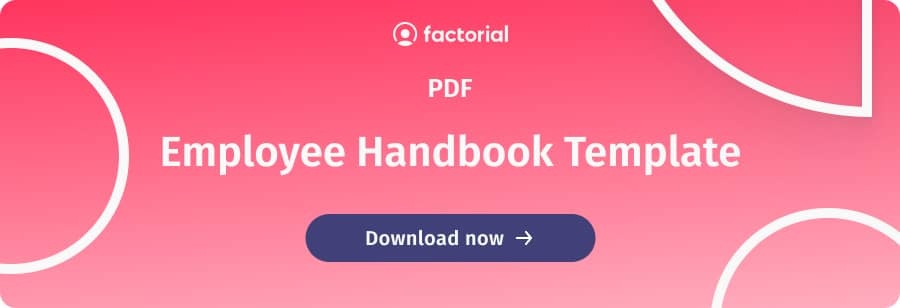Company policies and procedures help your workplace run more efficiently. They ensure consistency, fairness, and compliance with US labor laws. Policies also help your employees know what is acceptable, and what is not tolerated. Plus, they reflect your company’s values, making it a better environment for all employees.
However, for your policies to be effective, they need to be comprehensive, inclusive, and well communicated. When you don’t implement them in the right way and take into account all aspects of the employee experience, you put your organization at risk.
- What are Company Policies and Procedures?
- What is the Purpose of Company Policies and Procedures?
- How to Create Company Policies and Procedures
- Which Company Policies and Procedures to Include
- An Employee Handbook Template for Small Businesses
- Centralize Company Policies and Procedures
- Create an Employee Portal with Factorial ✅
In this post, we will discuss what policies are and why they are so important. We will also share suggestions on which ones you should include in your employee handbook. Finally, we will take a look at some of the tools you can use to ensure you effectively implement and communicate your policies at every level of your company.
What are Company Policies and Procedures?
Company policies and procedures are a set of internal guidelines that establish the rules and expectations of your company. They help you communicate to employees what they can and can’t do, and how they should do it.
Let’s start with the basics:
Policies: a framework of rules and regulations in your company. They establish guidelines for how potential issues are managed and they align an organization’s vision and values with its day-to-day operations. Examples of company policies include employee conduct policies, dress code, attendance policies, equal opportunity policies, and other areas related to the terms and conditions of employment.
Procedures: the processes by which employees should deal with potential breaches of company policies. For example, if they witness discrimination, how they should report it.
Each policy you create should:
- set out the aim of the policy
- explain why the policy was developed
- list who the policy applies to
- set out what is acceptable or unacceptable behavior
- set out the consequences of not complying with the policy
Business Management Software made simple, powerful, and scalable.👇

What is the Purpose of Company Policies and Procedures?
Think of your company policies and procedures as the rules of conduct of the organization which outline the responsibilities of both employees and employers. They aim to both protect the legal rights of employees and the business interests of employers. They also communicate the values and vision of your organization, ensuring your employees understand exactly what is expected of them in certain situations.
This usually includes:
- General company rules on the most appropriate way to behave (dress codes, social media policies, smartphone use, etc.)
- Guidance for handling common scenarios (codes of conduct, attendance and leave, remote work, travel and expenses, etc.)
- Legal issues (harassment and discrimination, etc.)
- Provisions for compliance with state and federal laws (Family and Medical Leave Act, Disabilities Act, the Equal Employment Opportunity Commission, etc.)
- Internal work standards and regulations (health and safety rules, breaks, smoking rules, etc.)
- Guidelines for the fair treatment of employees (benefits and compensation policy, paid time off, bereavement, etc.)
How to Create Company Policies and Procedures
- Establish your goals for each policy and explain these goals to your employees. Design an HR strategy to clarify your direction with each policy and create an annual HR plan to guide your HR department in line with your mission and values.
- Write and review your policies. Make sure your policies cover the basics and address any questions that employees might have. Get your legal department to make sure everything is in line. Establish a pilot group of employees to review your policies and give feedback. Make adjustments where necessary.
- Get management support. This is a crucial step as if your managers aren’t on board then it will be much harder to implement and communicate your policies to employees.
- Implement your policies and distribute them to employees. Depending on the size of your company and your HR to employee ratio, you can do this individually, in small groups, or at a company-wide meeting. Give digital or paper copies of all policies to all employees and get them to sign a document confirming they have received and understood them.
- Include policies in your employee handbook and make sure all new starters are given a copy during their onboarding phase. If you have a company intranet, include copies there also so that all employees have access at all times.
- Review and update your policies on a regular basis to make sure they are in line with any changes to federal, state, and company regulations. You should also update them whenever there are any organizational shifts, as part of your change management plan.
Which Company Policies and Procedures to Include
The company policies and procedures you include in your employee handbook will depend on a number of factors, including the size of your company and the nature of your business. You also need to ensure compliance with state and federal labor laws, including the Family and Medical Leave Act (FMLA), the Fair Labor Standards Act (FLSA), and the Occupational Safety and Health Act (OSHA), amongst others.
You can find out more about company policies and procedures you should create in our handy downloadable employee handbook template. Here are a few examples to give you an idea.
Employee Conduct Policy
An employee conduct policy defines your expectations about how your employees should behave. It usually outlines aspects including proper dress code, use of social media and smartphones, acceptable behavior in the workplace, and social norms. Your employee code of conduct policy should reflect your vision, core values, and the overall culture of your organization.
Time Off and Attendance Policy
A time off and attendance policy outlines your rules and guidelines relating to work schedules and absences. It should define how your employees should schedule paid or unpaid time off or notify their managers of absences or late arrivals. It should also establish the consequences of failing to adhere to absence procedures.
Workplace Health, Safety & Security Policy
A health and safety policy is essential. It defines rules and guidelines so that your employees work in a safe environment that doesn’t compromise their health. It also protects you as an employer from potential accidents and safety incidents that could land you in court. For example, your policy should clearly define the procedure for completing an incident report so that any potential incidents are well documented.
Aside from protecting you and your employees, a security policy helps you protect your physical and intellectual property as well. For example, you could include guidelines for the use of ID cards to enter your building and best practices for signing out company laptops or smartphones.
Equal Opportunities Policy
Finally, an equal opportunities policy can help you promote fair treatment in the workplace. This includes the use of anti-discrimination and affirmative action policies that discourage inappropriate behavior at all levels of your company. You could also outline any diversity initiatives or workplace harassment training your company offers to send a clear message that keeping your employees safe and treating them fairly is a top priority for you.
An Employee Handbook Template for Small Businesses
The best way to distribute your company policies and procedures is with an employee handbook. It provides you with a centralized resource that communicates all your policies in an easily accessible written format. This helps your new and existing employees understand what is expected of them at all times. It also protects you from potential claims of discrimination or unfair treatment.
The way you design your large or small business employee handbook will have a huge impact on how effective it is. You need to provide as much information as possible so that your policies are clear. But you also need to make sure your handbook isn’t too overwhelming otherwise your employees won’t read it. It’s all about finding the right balance between communicative and overloaded.
Centralize Company Policies and Procedures
The best way to ensure this is by using the right technology, such as Factorial’s all-in-one software solution. Just upload your policy template to the employee portal to create all your policies in one place. If you don’t already have a template, Factorial’s free employee handbook template is a great resource that helps you design all your policies, safe in the knowledge that you are including all the right information.
You can then create, distribute, and update your policies as often as you need. Plus, with our template, you can customize your layout, check legal compliance, and set reminders for updates. And the best part is that the employee portal makes it easy for your employees to access up-to-date policies whenever they need to.



